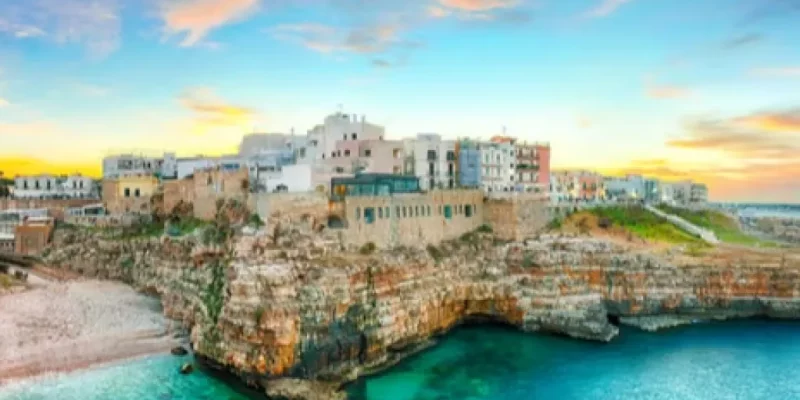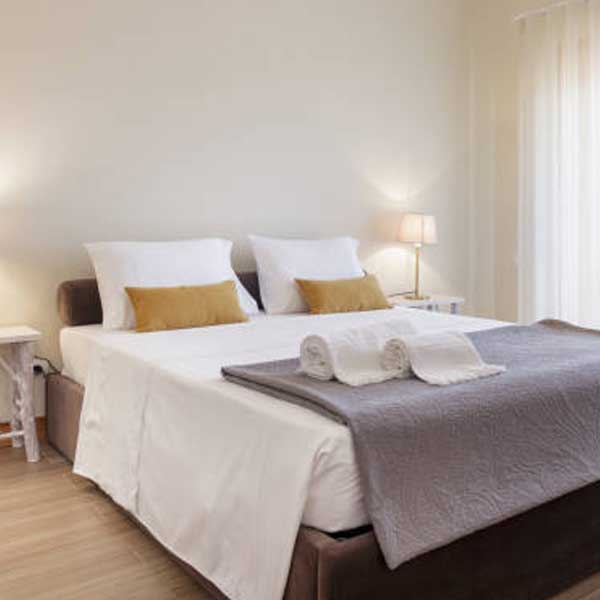- Payment Options
- Terms Conditions
- US
- IT
- ES
- My Bookings
- Add Your Review

Dettagli
TIPO DI POSIZIONE
Spiaggia
DISTANZA
65.9Km
INDIRIZZO
70044 Metropolitan City of Bari
Polignano a Mare è una delle località più spettacolari e frequentate della costa pugliese
Arroccato sul ciglio di un’alta scogliera che si erge dal mare Adriatico, Polignano a Mare è una delle località più spettacolari e frequentate della costa pugliese. Il centro storico di questo borgo di mare è un dedalo di viuzze che degrada verso una minuscola spiaggia, la Lama Monachile, che taglia in due la scogliera. Sotto l’abitato, un groviglio di grotte invita a scoprire un mare limpidissimo.
Polignano è anche la città natale di Domenico Modugno, l’autore de Nel blu dipinto di blu, la canzone italiana più famosa nel mondo. Il nucleo storico di Polignano a Mare, centro abitato fin dal Neolitico, è una distesa di case bianche di origine medievale affastellate sulla scogliera. Al borgo si entra passando sotto il cinquecentesco l’Arco Marchesale, noto anche come Porta Grande, che fino al 1780 è stato l’unico punto di accesso al paese che era circondato da un fossato, oggi nascosto da piazza Garibaldi, con relativo ponte levatoio.
Per le stradine di Polignano potete perdervi, tanto prima o poi sbucherete ad un affaccio sul mare e l’effetto sorpresa sarà ancora maggiore.
Troverete senz’altro la Chiesa Matrice, del Duecento, il palazzo Marchesale, dimora dei feudatari, il palazzo dell’Orologio e i 4 torrioni difensivi. Il luogo più fotografato di Polignano a Mare è la sua spiaggetta dall’acqua turchese, la Lama Monachile, sempre molto affollata dei mesi estivi: il ponte che sorge alle sue spalle è costruito sopra un ponte romano della via Traiana, la Roma-Brindisi dell’antichità, che passava proprio qui. Lì accanto, sul lungomare, vedrete la statua dedicata al polignanese più celebre al mondo, il cantante Domenico Modugno.
Dalla parte opposta del paese, sempre con spettacolare vista mare, c’è il bel museo della Fondazione Pino Pascali, un artista originario di Polignano scomparso negli anni Sessanta, che espone mostre di arte contemporanea.
L’atmosfera di Polignano a Mare si assapora passeggiando sulla scogliera e scendendo sul litorale da cui la vista sulla città bianca è spettacolare. In quaranta minuti a piedi in direzione Nola, tra le deliziose baie di Ponte dei Lapilli e Porto Cavallo, entrambe ideali per fare un bel bagno, arrivate al villaggio di San Vito, inconfondibile per la presenza dei resti dell’omonima abbazia che risale al IX secolo, ai tempi dei monaci basiliani che si rifugiarono in queste terre in fuga dalle lotte iconoclaste dell’Impero bizantino.
Poco più avanti c’è la torre quadrangolare di San Vito davanti a uno specchio di mare che sembra una piscina naturale. Di giorno come si sera, in questo luogo idilliaco ricco anche di locali e ristoranti, non sarete mai soli: la movida di Polignano arriva fino a qui. Sono una ventina le grotte che il mare ha creato con la forza delle sue onde sulla scogliera su cui sorge Polignano: la più grande è la grotta Palazzese, chiamata così perché si trova sotto un palazzo nobiliare dal quale si poteva accedere. Oggi il palazzo è stato trasformato in un hotel 5 stelle che negli anfratti naturali della scogliera ha ricavato le sale del ristorante e la grotta resta accessibile via mare.
Altre grotte hanno i nomi più impensabili, legati perlopiù all’uso delle stesse che si è fatto nel tempo: quella dell’Arcivescovado sarebbe stata collegata attraverso cunicoli al palazzo del vescovo, quella delle Monache veniva usata dalle suore dell’ospedale. La più suggestiva è l’Ardito, dal nome dei suoi proprietari, che al suo interno ha una colonna naturale sulla quale i pescatori si arrampicavano per salire in paese. Su una delle tante terrazze che si affacciano sulla scogliera, nei numerosissimi ristoranti di Polignano, potete gustare tutto l’anno piatti di crudità di mare, un misto di seppie, gamberi, scampi e tanti altri pesci a seconda della stagione e del pescato. Per chi il pesce lo preferisce ben cotto, allora il piatto da provare è riso, patate e cozze.
Altra specialità locale è la dolcissima carota di Polignano, coltivata proprio nella zona dell’abbazia di San Vito, riconosciuta come presidio Slow Food. Se preferite lo street food per non perdervi neanche un minuto di spiaggia, allora provate il panino con il pesce, con tartare di tonno, burrata e pomodori, oppure con il polpo fritto e le cime di rapa, una vera delizia.
A fine pasto concedetevi il Caffè Speciale, secondo la ricetta messa a punto proprio qui a Polignano: è un caffè zuccherato con aggiunta di scorza di limone, panna e amaretto, servito rigorosamente in un bicchierino di vetro.
Polignano a mare

Details
LOCATION TYPE
Beach
DISTANCE
65.9Km
ADDRESS
70044 Metropolitan City of Bari
Polignano a Mare is one of the most spectacular and popular locations on the Apulian coast
Perched on the edge of a high cliff rising from the Adriatic Sea, Polignano a Mare is one of the most spectacular and popular locations on the Apulian coast. The historic center of this seaside village is a maze of narrow streets that slope toward a tiny beach, the Lama Monachile, which bisects the cliff. Below the settlement, a tangle of caves invites you to discover a crystal-clear sea.
Polignano is also the hometown of Domenico Modugno, the author of Nel blu dipinto di blu, the most famous Italian song in the world. The historic core of Polignano a Mare, a center inhabited since Neolithic times, is an expanse of white houses of medieval origin clustered on the cliff. The village is entered by passing under the sixteenth-century Marchesale Arch, also known as Porta Grande, which until 1780 was the only point of access to the village that was surrounded by a moat, now hidden by Piazza Garibaldi, with its drawbridge.
Through the narrow streets of Polignano you can get lost, so sooner or later you will come out at an overlook to the sea and the surprise effect will be even greater.
You will undoubtedly find the 13th-century Matrix Church, the Marchesale Palace, home of the feudal lords, the Clock Palace and the 4 defensive towers. The most photographed place in Polignano a Mare is its turquoise-water beach, Lama Monachile, always very crowded of the summer months: the bridge behind it is built over a Roman bridge of the Via Traiana, the Rome-Brindisi of antiquity, which passed right through here. Next door, on the waterfront, you will see a statue dedicated to the world’s most famous Polignanese, singer Domenico Modugno.
On the opposite side of town, again with a spectacular sea view, is the fine museum of the Pino Pascali Foundation, an artist originally from Polignano who died in the 1960s, which displays contemporary art exhibitions.
The atmosphere of Polignano a Mare can be savored as you stroll along the cliff and down to the shoreline from which the view of the white city is spectacular. Forty minutes on foot in the direction of Nola, between the delightful bays of Ponte dei Lapilli and Porto Cavallo, both ideal for swimming, you arrive at the village of San Vito, unmistakable for the presence of the remains of the abbey of the same name, which dates back to the 9th century, to the time of the Basilian monks who took refuge in these lands as they fled the iconoclastic struggles of the Byzantine Empire.
A little further on is the quadrangular tower of St. Vitus in front of a stretch of sea that looks like a natural swimming pool. By day as well as by night, in this idyllic place also full of clubs and restaurants, you will never be alone: Polignano’s movida reaches here. There are about 20 caves that the sea has created with the force of its waves on the cliff on which Polignano stands: the largest is the Palazzese cave, so called because it is located under a noble palace from which it could be accessed. Today the palace has been transformed into a 5-star hotel that in the natural ravines of the cliff has created restaurant rooms, and the cave remains accessible by sea.
Other caves have the most unthinkable names, mostly related to their use over time: the Archbishop’s Cave would have been connected through tunnels to the bishop’s palace, the Nuns’ Cave was used by the nuns of the hospital. The most striking is the Ardito, named after its owners, which inside has a natural column on which fishermen used to climb to the village. On one of the many terraces overlooking the reef, in Polignano’s many restaurants, you can enjoy year-round dishes of seafood crudités, a mixture of cuttlefish, shrimp, scampi, and many other fish depending on the season and catch. For those who prefer their fish well cooked, then the dish to try is rice, potatoes and mussels.
Another local specialty is the very sweet Polignano carrot, grown right in the area of San Vito Abbey and recognized as a Slow Food Presidium. If you prefer street food so you don’t miss a minute of the beach, then try the fish sandwich, with tuna tartare, burrata and tomatoes, or fried octopus and turnip greens, a real treat.
At the end of the meal, indulge in the Caffè Speciale, according to a recipe perfected right here in Polignano: it is a sweetened coffee with added lemon zest, cream and amaretto, served strictly in a small glass.



